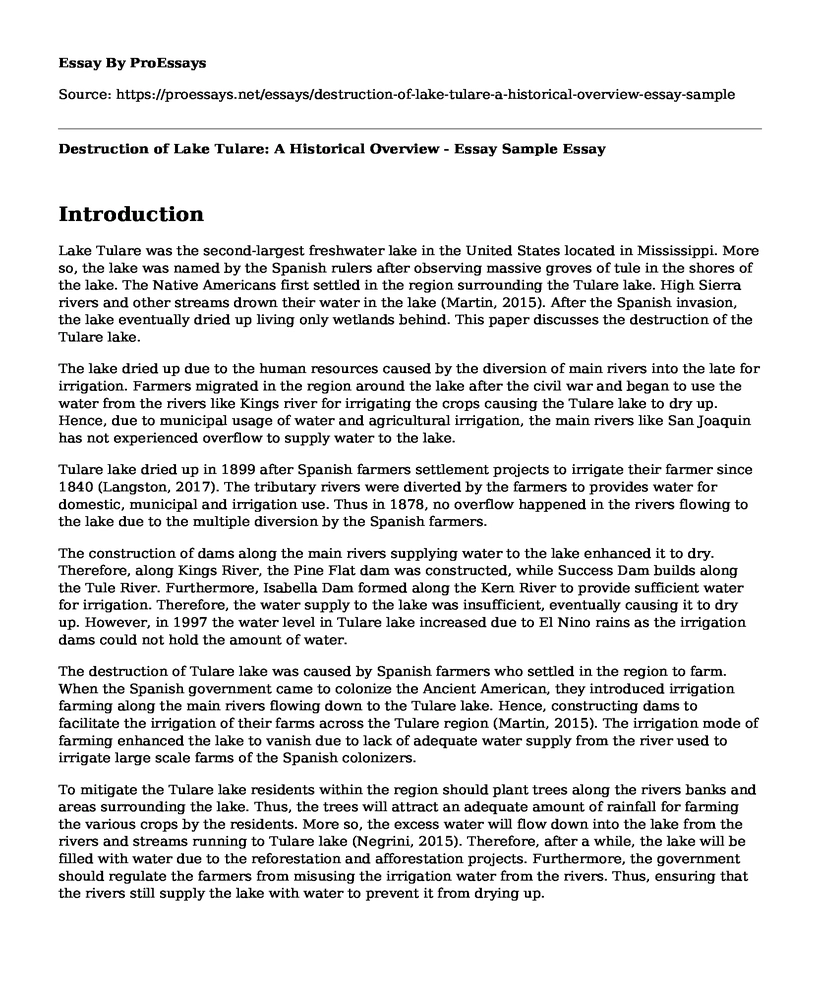Introduction
Lake Tulare was the second-largest freshwater lake in the United States located in Mississippi. More so, the lake was named by the Spanish rulers after observing massive groves of tule in the shores of the lake. The Native Americans first settled in the region surrounding the Tulare lake. High Sierra rivers and other streams drown their water in the lake (Martin, 2015). After the Spanish invasion, the lake eventually dried up living only wetlands behind. This paper discusses the destruction of the Tulare lake.
The lake dried up due to the human resources caused by the diversion of main rivers into the late for irrigation. Farmers migrated in the region around the lake after the civil war and began to use the water from the rivers like Kings river for irrigating the crops causing the Tulare lake to dry up. Hence, due to municipal usage of water and agricultural irrigation, the main rivers like San Joaquin has not experienced overflow to supply water to the lake.
Tulare lake dried up in 1899 after Spanish farmers settlement projects to irrigate their farmer since 1840 (Langston, 2017). The tributary rivers were diverted by the farmers to provides water for domestic, municipal and irrigation use. Thus in 1878, no overflow happened in the rivers flowing to the lake due to the multiple diversion by the Spanish farmers.
The construction of dams along the main rivers supplying water to the lake enhanced it to dry. Therefore, along Kings River, the Pine Flat dam was constructed, while Success Dam builds along the Tule River. Furthermore, Isabella Dam formed along the Kern River to provide sufficient water for irrigation. Therefore, the water supply to the lake was insufficient, eventually causing it to dry up. However, in 1997 the water level in Tulare lake increased due to El Nino rains as the irrigation dams could not hold the amount of water.
The destruction of Tulare lake was caused by Spanish farmers who settled in the region to farm. When the Spanish government came to colonize the Ancient American, they introduced irrigation farming along the main rivers flowing down to the Tulare lake. Hence, constructing dams to facilitate the irrigation of their farms across the Tulare region (Martin, 2015). The irrigation mode of farming enhanced the lake to vanish due to lack of adequate water supply from the river used to irrigate large scale farms of the Spanish colonizers.
To mitigate the Tulare lake residents within the region should plant trees along the rivers banks and areas surrounding the lake. Thus, the trees will attract an adequate amount of rainfall for farming the various crops by the residents. More so, the excess water will flow down into the lake from the rivers and streams running to Tulare lake (Negrini, 2015). Therefore, after a while, the lake will be filled with water due to the reforestation and afforestation projects. Furthermore, the government should regulate the farmers from misusing the irrigation water from the rivers. Thus, ensuring that the rivers still supply the lake with water to prevent it from drying up.
Conclusion
In conclusion, Tulare lake is one of the largest freshwater lakes in the United States. Thus, it should be the responsibility of the government to maintain the heritage of the lake by preventing it from drying up. Therefore, the government should impose appropriate regulations to the farmers to prevent them from misusing the water from the rivers. Hence, allowing the streams to still flow down to the lake.
References
Langston, N. (2017). Ecological History of the Tulare Lake Basin. Sustaining Lake Superior. https://doi.org/10.12987/yale/9780300212983.003.0001
Martin, E. (2015). Tulare Lake was once considered the largest body of water west of Mississippi. The Leader. https://www.mylemooreleader.com/125818
Negrini, R. (2015). Holocene lake-level history of Tulare Lake, California as input for Sierra Nevada river discharge forecasts: Progress report. Quaternary International, 387, 140-141. https://doi.org/10.1016/j.quaint.2015.01.157
Cite this page
Destruction of Lake Tulare: A Historical Overview - Essay Sample. (2023, Apr 24). Retrieved from https://proessays.net/essays/destruction-of-lake-tulare-a-historical-overview-essay-sample
If you are the original author of this essay and no longer wish to have it published on the ProEssays website, please click below to request its removal:
- Global Warming: Pollution and How It Can Be Reduced Essay
- Argumentative Essay on Carbon Tax as a Solution to Climate Change
- Research Paper on Global Water Shortage
- An Analysis of the Effects of Global Warming on Climatic Changes
- Public Health After Natural Disasters: A Case Study of Pakistan Flood 2010
- Essay Sample on France's Race Against Climate Change: European Regulations, Taxes, and Hefty Fines
- Report Example on Management of Stormwater







